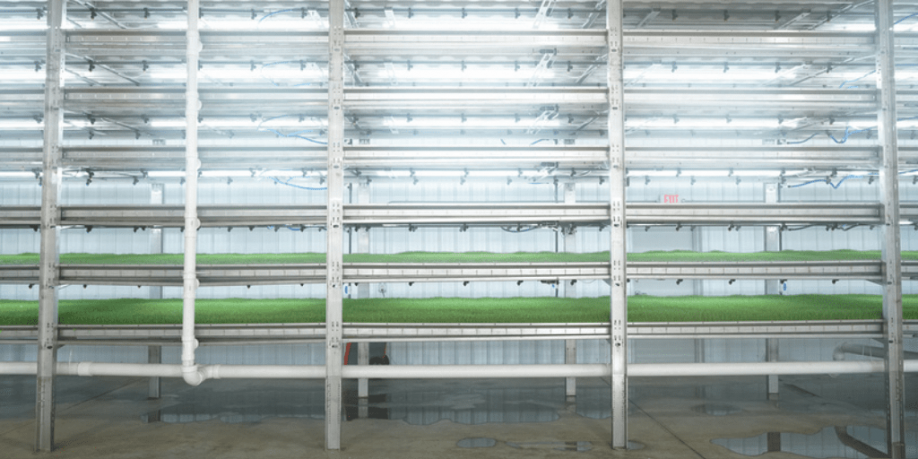CubicFarms and Deloitte Join Forces on New Carbon Commercialization Program

Building on university research confirming greenhouse gas emission reductions from using its indoor growing technologies, CubicFarm® Systems Corp. (“CubicFarms” or the “Company”) (TSX:CUB), a leading local chain agricultural technology company, today announced that its HydroGreen division has entered into an agreement with Deloitte LLP to develop a carbon commercialization program designed to provide high-quality carbon credits to a fast-growing global market.
HydroGreen’s commercial scale Automated Vertical Pastures™ technology helps meet increasing demand for valuable farm-based inset and offset carbon credits from all manner of organizations with net-zero goals. HydroGreen will be uniquely positioned to supply carbon credits through the Company’s agreement with Deloitte.
New research data demonstrates that feeding cows fresh livestock feed grown indoors in the Company’s Automated Vertical Pastures™ significantly reduces methane emissions.
- Feeding dairy cows HydroGreen fresh forage lowers methane emissions by approximately 24 per cent on a per unit milk output basis. As a greenhouse gas (“GHG”), methane’s 100-year global warming potential is up to 34 times greater than that of CO2. Measured over a 20-year period, that ratio more than doubles.
- Preliminary studies of beef cattle have demonstrated up to approximately 48 per cent lower methane emissions on a per kilogram weight gain basis.
- Overall, every cow fed HydroGreen fresh forage reduces methane emissions by about one metric tonne of CO2 equivalents, per year, per animal.
- HydroGreen further cuts GHG emissions by reducing the number of acres needed to grow feed crops, which in turn eliminates the need to till, fertilize, and irrigate those lands, as well as ship feed long distances.
HydroGreen is working with Deloitte’s world-class advisory team to further quantify the extent to which Automated Vertical Pastures™ can deliver carbon insets and offsets. Third-party standards, such as Verra, can then be used to monetize GHG emission reductions by converting them into tradeable carbon credits.
“With about a third of global methane emissions coming from livestock, this data validates the GHG-reducing power of local chain ag-tech like never before,” said Dan Schmidt, President, HydroGreen. “HydroGreen is unrivaled in the plant science and animal performance benefits of its automated indoor growing system for fresh forage. We’re excited to develop HydroGreen’s carbon program with Deloitte and ultimately make a huge difference in reducing global methane levels one cow at a time, every year, for years to come.”
“We’re thrilled to develop a carbon program for HydroGreen by leveraging our extensive background in carbon management for agriculture and livestock,” said Nathan Steeghs, a Partner in Deloitte’s Sustainability & Climate Change practice. “We need to focus on tech solutions that can help close the emissions gap in getting to net-zero and we believe in investing in solutions that are commercially viable today and technologies that have the potential to unlock significant carbon reductions for future generations.”
Researchers gathered over 200,000 data points during a comparison study with 344 jersey dairy cows and 244 beef cattle. Results demonstrated how hydroponically sprouted grains grown in HydroGreen’s Automated Vertical Pastures™ not only reduce methane in dairy cows and beef cattle but also improve feed efficiency, cow health, nutrition, and performance outcomes.
“HydroGreen’s new carbon credit program delivers on-farm methane reductions that can be used by companies to effectively meet their urgent net-zero requirements,” said Yoav Levsky, commercial dairy innovator, Chair and Partner of Total Dairy Solutions U.S.A., a global leader in dairy farm solutions. “We see HydroGreen’s technology as one of the world’s most valuable patents for addressing climate change with meaningful livestock methane reductions.”
Earlier this month, CubicFarms announced new data showing that as much as 62 percent less energy is used in a CubicFarm System module compared to results reported by other vertical farms. “With electricity being the number one input cost in vertical farming, and with the burning of fossil fuels for power generation being one of the top sources of GHGs, CubicFarms’ local-chain ag-tech provides enormous benefits to both farmers and organizations working to reduce their carbon footprints,” said CubicFarms CEO Dave Dinesen. “It’s heartbreaking to see the devastation of climate change and long supply chain disruptions impact so many people and economies, which is why we are so focused on leveraging ag-tech to provide solutions today and give hope for future generations.”
About HydroGreen
HydroGreen’s Automated Vertical Pastures™ technology utilizes a unique process to sprout grains, such as barley and wheat, in a controlled environment with minimal use of land, labour and water. HydroGreen’s fully automated indoor growing technology performs all growing functions including seeding, watering, lighting, harvesting, and re-seeding – all with the push of a button – to deliver nutritious fresh forage for livestock without the typical investment in fertilizer, chemicals, fuel, field equipment, and transportation. Automated Vertical Pastures™ not only provide superior nutritious feed to benefit the animal, but also enables significant environmental benefits to the farm.
About CubicFarms
CubicFarms is a leading local chain agricultural technology company developing and deploying technology to feed a changing world. Its proprietary ag-tech solutions enable growers to produce high quality, predictable produce and fresh livestock feed with HydroGreen Nutrition Technology, a division of CubicFarm Systems Corp. The CubicFarms™ system contains patented technology for growing leafy greens and other crops onsite, indoors, all year round. CubicFarms provides an efficient, localized food supply solution that benefits our people, planet, and economy.
For more information, please visit www.cubicfarms.com.
Comments (0)
This post does not have any comments. Be the first to leave a comment below.
Featured Product

